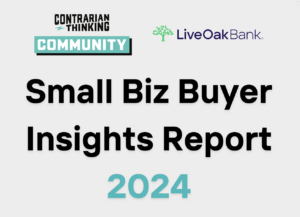
Hey Contrarians,
Let’s summarize the first 11 days of 2024. So far:
- Another Boeing plane malfunctioned (to which someone virally asked whether it’s considered insider trading to short Boeing stock if you’re ON THE PLANE)
- The SEC’s Twitter got hacked (…and used to promote a Bitcoin ETF)
- The Bass Pro Shop guy spawned outta nowhere (hard to unsee that one)
- A man got stuck in a decorative urn at a wedding (the video deserves an Oscar)
- Uncertainty continued around that economic “soft landing” or whether real recessionary risks are persisting (sorry to dampen the mood)
All that’s to say, we have no clue what’s in store, which means that more than ever, the best time to focus, learn, and build is now. So today we’re turning the newsletter into a playground for building a biz in 2024…

Today in 5 minutes or less, you’ll learn:

Contrarian framework: The Money Matrix
As of last year, there were approximately 33,185,550 small businesses in the US.
That means there are at least that many small business ideas that have actually been brought to fruition. The truth is, many won’t last, and we can’t tell you exactly which is right for you.
But we can tell you that you fall into one of the 4 categories on the Money Matrix below – and that this matrix could help you clarify which biz to focus your time and energy on this year.
So here’s how it breaks down.
Our X-axis is skill. Our Y-axis is money. This gives us 4 quadrants.

A “low-money” quadrant means you could get by with relatively low startup costs – and relatively low risk. A “low-skill” quadrant means you don’t necessarily need specific, marketable know-how to get started. And vice versa for both.
Let’s pull back the curtain a bit on this.
Low-skill, low-money
- Type: Simple service businesses
- Money level: 1/10 (depending on the biz)
- Skill level: 3/10 (don’t be an idiot)
- Risk level: 2/10
- Reward: Huge range potential (low thousands early on → millions after years of scaling)
- Time commitment: 8/10 (it’s going to take up a lot of time, at least until you make enough to hire the person who’s going to take over the day-to-day for you…)
Low-skill, high-money
- Type: Small, boring biz acquisitions
- Money level: Ideally 6-figures (but can be higher or lower)
- Skill level: 5/10 (formal experience helps, but anyone can learn)
- Risk level: 7/10 (you can take steps to de-risk a purchase somewhat)
- Reward: 8/10 (if you buy a longtime cash-flowing biz that’s already profitable, the likelihood of that continuing is probably better than your chances of launching a business from scratch and succeeding in the long term)
- Time commitment: Wide range, depending on the business
High-skill, low-money
- Type: Consultant, productized service, Product as a Service
- Money level: 2/10 (depending on the biz)
- Skill level: 8/10 (you need some deep, marketable skills)
- Risk level: 2/10 (likely just some monthly subscription costs, nothing crazy)
- Reward: Depending on the skillset, potential for 4, 5, or 6 figures in highly successful cases (remember the $120k biz coach story?)
- Time commitment: 6/10
High-skill, high-money
- Type: Software company
- Money level: More than you think (remember, this is where the big VC dollars go)
- Skill level: 9/10 (lots of know-how, lots of competition)
- Risk level: 8/10
- Reward: 10/10 potential with scale (but 0/10 is more likely)
- Time commitment: 8/10 or higher
To us, seeing people use the Money Matrix to identify a focus area, act on a biz in that area, and then scale toward financial freedom is the far less sexy but still gangster business equivalent of Keanu Reeves evading a hail of bullets in a visually stunning display that blends cutting-edge special effects with an almost balletic grace.
Aka, it’s our happy place.

2 recession-resistant ideas to get your gears turning
Now it’s time to make a move on a business that’s right for you. As we said, there are (at the very least) 33,185,550 ideas out there that somebody’s tried out.
You just need 1, and today we’re going to get your gears turning around 2.

1. A simple service biz that can scale
Here’s why simple, service businesses just… make… sense…
- They’re often beginner-friendly, usually with little formal training and licensing required
- There’s often low upfront capital expenditure (depending on the biz)
- You’ve got the potential for high-margin, recurring revenue
- There’s less shipping and supply chain nonsense than other business types
- You can offer B2B options that cost more (think: mowing your neighbor’s lawn versus mowing an office building’s lawn)
- Finding clients is easier (you live next to them!)
- The road to scale can be very clear
Remember the video we made a while back about how two 19-year-olds turned a few hundred bucks into a $65,000 month from window cleaning? Check it out.
2. A small biz acquisition
This one’s an often stressful, sometimes lifelong grind and a half.
But buying a simple business, with a business model you can explain to grandma, can be effective and rewarding.
Here’s the deal, though. We (humans) should only buy businesses that cash flow. We don’t buy dreams. We buy realities and profits.
Buying a business that keeps the lights on in a downturn ain’t easy, but it can follow a simple framework, and it sounds like an A-10 Thunderbolt…
Ladies and gents, the BRRT method:

- Buy a cash-flowing biz (ideally one that’s inexpensive and under-performing but profitable, like that grungy laundromat down the street)
- In a recession-Resistant sector (nobody likes wearing dirty clothes, even when cash is tight)
- Raise prices with inflation and as value is added (do a load yourself = $2.75. get wash & fold service = $30)
- Add Tech (toss in digital payments, reliable machines, free wifi, and tell me people won’t pay a bit more)
Easy? No. Possible? You bet.
Formal experience helps, but anyone with common sense and an uncommon amount of grit is capable of learning the ropes in businesses like these.
To buy a business, you don’t necessarily need to have deep experience in either biz-buying or the specific business itself.
(Keep reading. This next part is cool…)
Just in the past week or so, we welcomed to our biz-buying community a:
- Product manager in the wellness-tech industry
- Professor of real estate
- Physician Assistant
- Analyst at a major financial services company
- Massage & skincare practice owner
- Active duty Air Force member
… and others.
These people aren’t plumbers & technicians, but they’re searching for small businesses in those kinds of fields anyway.

The PROMISE method for scaling simple service biz’s
So you have your focus, you have the business, and now it’s time to scale. And how the hell do you do that…?
Oh, look, a cool graphic about a tactical framework on this very subject. How random?!

Here’s how the PROMISE Method works:
P = Profit / Protected margins
One thing we want to do more than anything else is protect the margins.
If you’re going to scale, you want to think about how you:
- Price things
- Manage costs
How do your prices compare to competitors and why? Are you the value guy or the quality guy? Where can you build efficiencies and save?
R = Recurring revenue
Sell once, charge continuously.
It’s the name of the game. Monthly and annual contracts — offer them. Auto renewals billed through subscription services like Jobber or Service Titan — leverage them. Loyalty programs — consider them.
O = Online presence
What do you do when you need a handyman? You go to Google (and increasingly, social media).
So, you need to establish local SEO authority. Try to get people to come to your little website and see you’re awesome. One of the best ways to do that is by making content. Ever been mesmerized by one of those power-washing timelapse videos? That could be you.
M = Mouth-to-mouth marketing
Here we’re talking about referrals.
Consider a strategy for referrals that looks like this: Every single time you get a new customer, follow up immediately afterward, ideally with a phone call (or if that’s too awkward for the GenZ’ers – a text). Thank them for the business, and ask them if they have any referrals in mind.
I = Interpersonal
In the beginning, this is how you get your first customers. Talk to your neighbors. You use the concentric circles. It won’t just build the brand, it’ll help you protect the margins by keeping things local.
S = Sales tiers and subscriptions
The great service businesses of today have tiered sales: The cheap offering to the left, the more expensive one to the right, and that Goldilocks one in the middle. Figure yours out, and make sure you have a subscription built in — most small biz’s don’t.
E = Expectations
Real talk. This one is about “reviews,” but we needed an E for the acronym. Let’s just roll with it.
Reviews are critical. Potential customers read them, unhappy people often leave them, and it takes many good ones to negate a bad one.
(FYI: We have MANY more resources on business reviews coming out later this week…)

What’s on tap for 2024?
God only knows what’s on tap for the rest of this year, let alone the rest of this week.
But there are some things we know.
First, if you say…
“That won’t work for me.” Then it won’t.
“How could that work for me?” It just might.
No one owes you anything in this world. You have to go out and get it. The good news: it costs little to show up, little to start learning, and little to take a first step.
And that first step is totally up to you.
Just don’t use it to get stuck in a decorative urn at a wedding.
– The Contrarian Thinking team


SO not boring…
▶️ The Problem Profit: Catch Codie helping Contrarian Community members work through real, tactical biz challenges in our new YouTube series
🤖 Contrarian Thinking Capital portfolio company Figure, which is working on humanoid robots, taught a robot to… make coffee
🤝 We’re hiring a Head of Marketing — please send the best marketers in the galaxy our way.




